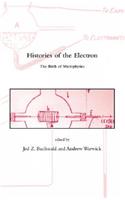
Histories of the Electron
Series: Dibner Institute Studies in the History of Science and Techn
In the mid to late 1890s, J. J. Thomson and colleagues at Cambridge's Cavendish Laboratory conducted experiments on cathode rays (a form of radiation produced within evacuated glass vessels subjected to electric fields)--the results of which some historians later viewed as the discovery of the electron. This book is both a biography of the electron and a history of the microphysical world that it
NaN
VOLUME
English
Paperback

In the mid to late 1890s, J. J. Thomson and colleagues at Cambridge's Cavendish Laboratory conducted experiments on cathode rays (a form of radiation produced within evacuated glass vessels subjected to electric fields)--the results of which some historians later viewed as the discovery of the electron. This book is both a biography of the electron and a history of the microphysical world that it opened up. The book is organized in four parts. The first part, Corpuscles and Electrons, considers the varying accounts of Thomson's role in the experimental production of the electron. The second part, What Was the Newborn Electron Good For?, examines how scientists used the new entity in physical and chemical investigations. The third part, Electrons Applied and Appropriated, explores the accommodation, or lack thereof, of the electron in nuclear physics, chemistry, and electrical science. It follows the electron's gradual progress from cathode ray to ubiquitous subatomic particle and eponymous entity in one of the world's most successful industries--electronics. The fourth part, Philosophical Electrons, considers the role of the electron in issues of instrumentalism, epistemology, and realism. The electron, it turns out, can tell us a great deal about how science works.About the Author: Vincent Walsh is a Royal Society Research Fellow and Reader in Psychology at the Institute of Cognitive Neuroscience, University College London.
Price Comparison [India]
In This Series
Bestseller Manga
Trending NEWS




















